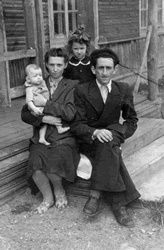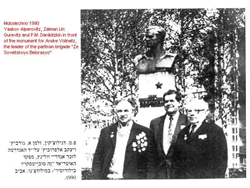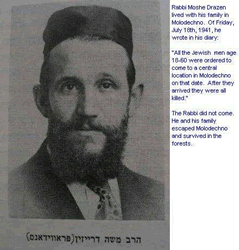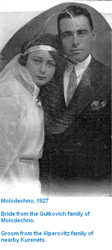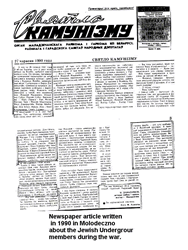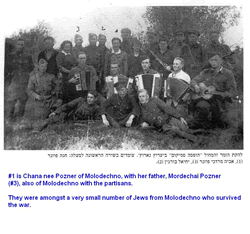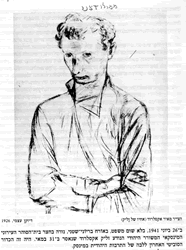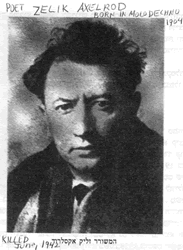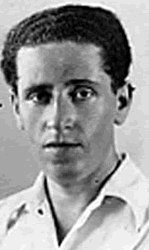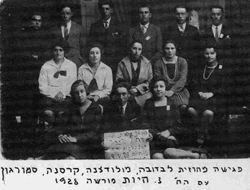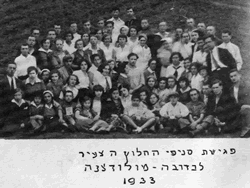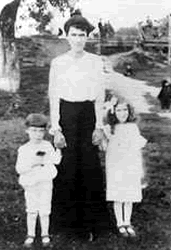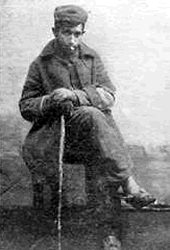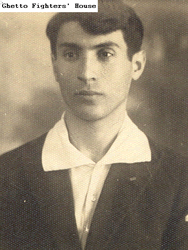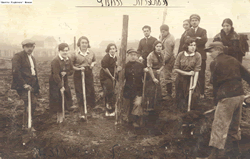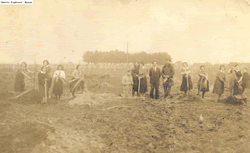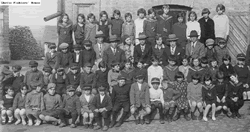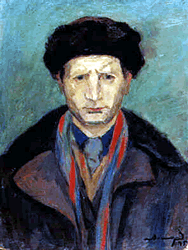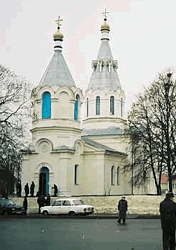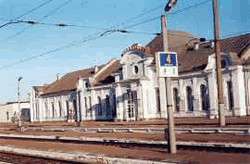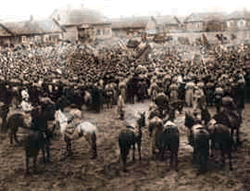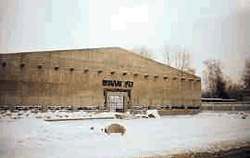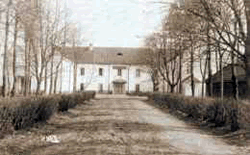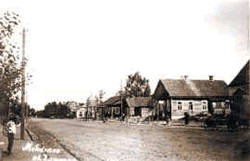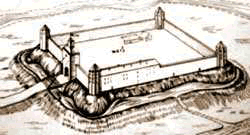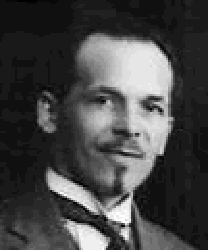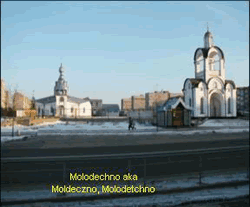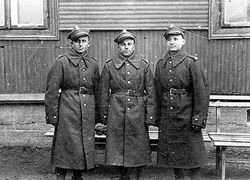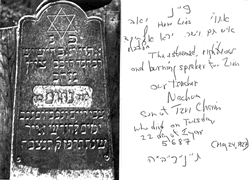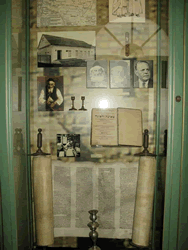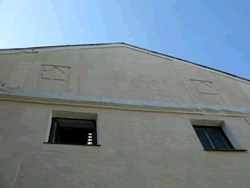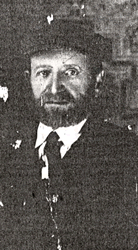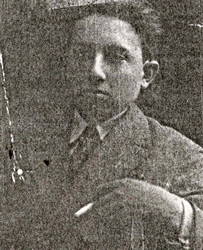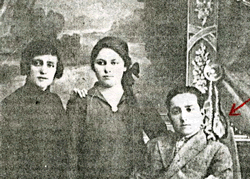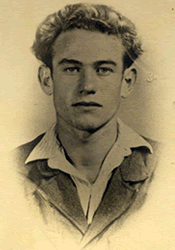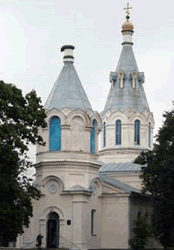|
#mal-1: Nachum Alperovich and family in Molodechno |
#mal-2:
|
#mal-3:
|
|
#mal-4:
|
#mal-5:
|
#mal-6:
|
|
#mal-7:
|
#mal-8:
|
#mal-9:Szmuel
(Mula) Dubrowski
Born in Molodechno 25/12/1916 Partisan; Battalion Woroshilov Resistance Organization Died in Israel in 1991 |
|
#mal-10: |
#mal-11: |
#mal-12:Fajga
Ajnsztajn posing outdoors with her two children, Szloyme and Resia.
1915. |
#mal-13: Portrait of Alter Kacowicz, ill since birth, detained in prison for seven months on false spying charges. |
#mal-14: Mordechai Berman from Molodechno, a member of the He - Chaluts movement from the "Shachariya" pioneering training commune in Vilnius July 7, 1935. |
#mal-15: Members of the local branch of the Chaluts movement in Molodechno. Photographed on October 31, 1932 |
#mal-16: Members of HaChaluts movement in Molodechno. |
#mal-20: A gathering of students of the "Tarbut" network's Hebrew day schools from several cities and towns in Poland. They came from Grodek, Postavy, Molodechno, and other places. Among the teachers in the photo, seated in the second row from the top are: Refael Daniszewski - Danis (second from the right), Miriam Golob (third from the right), Israel Berman (second from the left), who was the principal of the Molodechno school; and Chazan (on the left; first name unknown). The meeting took place in 1929. |
#mal-21: Meir AXELROD (1902 - 1970) Born in Molodechno in 1902, forced to leave his home together with his family during the World War I, a student and later a teacher at the famous Vkhutemas and member of the "4-Arts" Society, he exhibited his work throughout the world. Subjected to criticism and abuse during the years of triumphant socialist realism and neglected, Axelrod remained faithful to his main theme – Jewish life, Jewish spirituality: in portraits, genre studies,Yiddish theater design, illustrations for Jewish classics and in compositions on the Holocaust theme, the thought of which haunted him all his life... |
#mal-22: |
#mal-23: |
#mal-24: |
#mal-25: |
#mal-26: |
#mal-27: |
#mal-28: |
#mal-29: Boruch Shalomonovitsch Kontarovitsch |
#mal-30: |
#mal-31: Zvi-Hirschel Kaliko (first from the right) in the Polish army uniform. On the back of the photo he wrote, "To my parents, brother and sister, |
#mal-32: Norm Lipson wrote: Family name was Lifschitz, |
#mal-33: There is a Jewish museum in MOLODECHNA and I took a few pictures |
#mal-34: The Jewish museum. |
#mal-35: Mr. Sobol was born in Molodechno in 1873. He perished in the holocaust. |
#mal-36: Mendel Perski was born in Molodechno in 1905. He perished in the holocaust. |
#mal-37: Mendel Persky with sisters? |
#mal-38: Mendel Perski was born in Molodechno in 1905. He perished in the holocaust. |
#mal-39: Yehoshua Kremer ( 1928- 1948) Survived the holocaust in the forest hiding with his baby sister. Both came to Israel after the war. Yehushua was killed fighting for Israel. |
Please share your comments or photos or links for posting on our Guestbook Page here: egl.comments@gmail.com
MOLODECZNO- (from Eckhard's Dictionary: Molodzieczno), a town and estate on the Usza River in the first police district of Wilia province, as well as a gmina and rural district. It lies on the postal road from Wilno to Minsk, and also within a mile of the Lipawa-to-Romny railroad line, 73 mi. from Wilno and 13 mi to the south of Wilejka. Miserably constructed, Molodeczno has 1,332 inhabitants (629 men & 703 women), mostly Jewish. There are two Orthodox churches-- a wooden parish church called Birth of Our Lady Mary, transformed in 1865 from a Catholic church; and a second, once a Uniate church, called Sts. Cosmas & Damian with a burial cemetery. There are also Jewish prayer houses, a public school, a seminary for rural teachers, home of the first police administration district, a chamber court and a Commissar for Peasant Affairs (peace mediator). Further there is present in Molodeczno a beautiful and extensive palace, formerly erected as a defensive castle by Prince Zbaraski. It was converted to a palace by later Oginski proprietors, who also erected a wooden Catholic parish church in Molodeczno in 1758 and brought in Trinitarians in 1762. These were settled within a walled monastery by Thaddeus and Anne (nee Radziwill) Oginski, the Castellan of Troki. The monastics possessed a suitably large library. A 5th-class school with a competent secondary school existed in Molodeczno until 1809, dedicated to learning [ed.-- in conjunction with Wilno University?]. Among those who were educated here-- Alexander Tyszynski, critic and professor of the chief Warsaw schools, and Anthony Muchlinski, orientalist, professor and Dean of the University of Petersburg, are the most famous. The school there was later changed into a seminary for rural teachers of the Orthodox faith.
Molodeczno is first mentioned around the year 1389, when Dimitry Korybut, Prince of Severian Novgorod, produced a document here on December 16th, assuring his tributary fidelity to (King of Poland-Lithuania) Wladislaw Jagiello and Queen Jadwiga. On July 6, 1501, King Zygmunt granted the Molodeczno estate and holdings to the Russian Prince [ed.-note: no translation for the term **kniahini**'; I use "knight" and some times "prince" e.g. Russ **knyazh**] Michael Iwanowiczow Mscislawski„ on the condition that the donatee provided a (river?) crossing (or passage) for Parliament members and hunters. King Zygmunt's grant confirmed the privileges on July 12, 1511. This Prince Michael Mscislawski died around 1525; leaving three daughters Nastasia, Theophila, and Agrippina.
[ed.-- the entire translation which follows could use expert review on the financial details and the other intricacies.] On May 4, 1558, Basil (Wasily) Rahoza exhibited a document, indicating the sale of Molodeczno manor known as the "Bewitched Zelazkowszczyzna", which he received from Prince Zbaraski, Voivod of Vitebsk, who had received it as a gift from Knight Bogdan Mscislawski. On May 1, 1561, Andrew Michaelowicz Sanguszko Koszyrski, Sheriff of Luck, registered a fourth part of Molodeczno to [ed.-- "kniahini" knight?] Bogdan Michaelow Mscislawski, who after obtaining a share for his sister, bought it from Basil Rahozy. In 1567, Molodeczno passed in its entirety to the property of Knight Nastasi Stefanow Zbaraski, Voivod of Troki, who bequeathed it to his descendants.
In 1617, the whole of Molodeczno became the possession of Lew Sapieha, Chancellor of Lithuania, who on August 20, 1631 sold it to Stanislaus Semiott, Chamberlain of Samogitia. Semiott registered the following farms of Molodeczno in a testament: Rajewszczyzna, Mysota, Dyrmowiczami, as well as the Sieliszcze estate and Lewkowa farm for his sons and the son of Waclaw Semiott, leaving a life-annuity to his only brother, on the stipulation that if, in part, the estate were to be disposed of [ed.--komukolwiek?] or else had acquired heavy debts, in that case the wealth was to pass not to the descendants of those abandoning it but into the ownership of the Pac family. On April 23, 1626, Waclaw Semiott applied for the Pisarzewszczyzna and Dyrmowicze estates on behalf of his son Stanislaus. Despite the stipulation in the testament of Stanislaw Semiott, the husband Waclaw Janowicz and Katherine on January 16, 1628 sold Molodeczno to Karpiow Semiott and various farmsteads to Alexander Gosiewski, Voivod of Smolensk for 87,825 zlotys, and after eviction from the Wierpianach and Gracizach estates, sold them for a military camp of a Samogitian prince. Consequently, plaintiffs of the grant filed a lawsuit in court. And so on November 18, 1652, they delivered a writ to Gosiewski's home with the suit of Nicholas, Casimir, Joan and Stanislaus Semiott and on behalf of (those) from Sluck and Przyjemsk and their spouses, as well as for Kotlem, at that time possessor of Molodeczno. But this unjust acquisition of the estate was confirmed in perpetuity despite the testament of Waclaw Semiott.
On September 18, 1711, Bishop Boguslaw Gosiewski sold Molodeczno to the Oginski family. In 1723, the Molodeczno properties, Hanuty, Bienicy Lewkowa and Sieliszcza went to Michael Kociell, Treasurer of Lithuania. In 1736, Casimir Kociell, (Sheriff of Markow), proprietor of Molodeczno and Hanuty, deposed a testament, from which it was produced that his daughter Rosalie was to acquire it (through marriage) to Casimir Oginski, Sheriff of Babinow. On May 13, 1738, Casimir and Rosalie (nee Kociell) Oginski bequeathed Molodeczno and certain farmsteads to Thaddeus Oginski, Clerk of Lithuania. On June 14, 1740, Pac, the Castellan of Polotsk, acquired half of Molodeczno, surrendering the rest to Marcian Oginski, Voivod of Vitebsk. (King) August III gave Thaddeus Oginski, Castellan of Troki, full privileges on November 14, 1740,..... [ed.-- partial translation ends here].
Editor's Note: All Slownik longitudes in this article have been converted to modern coordinates which is based on the Greenwich zero meridian. All Polish measurement units (land areas, distances, height above sea level, etc.) were converted to American-English equivalents. Monetary units, where identified, were left in zlotys/zl. or rubles/rs.
Source: Slownik Geograficzny Królestwa Polskiego - Warsaw [1885, vol. 6]
History of Molodeczno in Belorussian;
http://rzecz-pospolita.com/wilen-index.php3
Maladzyechna Molodechno
From Wikipedia, the free encyclopedia
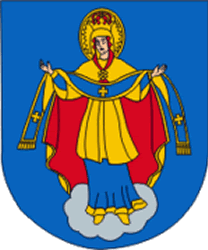
Coat of Arms of Maladzyechna
Maladzyechna (Belarusian: МаладзеÌ?чна, IPA: [maÉ«a'dzʲetÊ‚na], Russian: МолодеÌ?чно, Polish: MoÅ‚odeczno), is a city in the Minsk Voblast of Belarus, an administrative centre of the Maladzyechna district (and formerly of the Maladzyechna Voblast). It has 98,514 inhabitants (2006 estimate)[1] and is located 72 km northwest of Minsk, at [show location on an interactive map] 54°19′N, 26°51′E. Located on the Usha River, it has been a settlement since 1388 when it was part of the Grand Duchy of Lithuania. It was also home to the Cold War facility Maladzyechna air base.
History
The fortification on the right bank of the Usha was first mentioned in 1388, although it is probable it was erected even before that date. Rectangular earthworks with stone walls 3,5 metres high and 11 metres wide formed the basis of the future castles and military camps formed on that location [2]. The town itself was first mentioned the following year in a document issued by Dymitr Korybut, Prince of Severian Novgorod, who on December 16 assured his tributary fidelity to his cousin, King Władysław Jagiełło and Jadwiga of Poland.
In 1501 the place was donated by King Sigismund I of Poland to certain Michael of Mstislav, on the condition that the latter provided a safe river passage for the nobles and hunters dwelling in the area. The privilege was further confirmed on July 12, 1511[3]
After Michael's heirless death, the locality passed through different hands until finally in 1567 it was acquired by Prince Nastasi Zbaraski, the voivod of Troki. In 1568, that is the following year, a battle took place in the vicinity of the castle, in which the 40,000 men strong army of the Polish-Lithuanian Commonwealth defeated the forces of Muscovy. In 1617 it was bought by Lew Sapieha, the Grand Chancellor of Lithuania . Around that time the village had 1000 inhabitants. On August 20, 1631 Sapieha sold it to Stanisław Siemiott, the chamberlain of Samogitia, who then divided the villages surrounding Maladzyechna among his sons. Following a testament conflict between the descendantd of Siemiott and Aleksander Gosiewski, the Voivod of Smolensk, the town remained a property of the Gosiewski family. During their ownership of Maladzyechna the fortifications were extended and strengthened significantly by addition of several bastions. Around that time Maladzyechna started to be referred to as a town, even though it was officially a village and was not granted with a city charter. Nevertheless, it served as a centre of trade and commerce for the surrounding villages and also gained significant profits from transit between Lithuania and Poland. In 1708 the castle was one of the headquarters of the Swedish Army of King Charles XII of Sweden, which led to its partial devastation in the effect of a battle between the Swedes and the Russian forces.
Town hall and a monument to Lenin
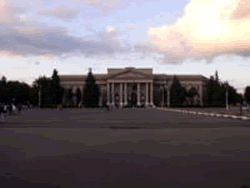
Town hall and a monument to Lenin
On September 18, 1711 Bishop Bogusław Gosiewski, sold the town to the mighty Ogiński family. Among the owners of the area were Kazimierz Ogiński and Tadeusz Ogiński, the Castellan of Troki (modern Trakai, Lithuania). The Ogiński family became the main benefactors of the area, as they made it one of the main centres of their domain. They erected a new, classicist palace with notable frescoes, as well as a late renaissance church. It was also them to ask the king Augustus II of Poland to grant the town with a city charter. Although it was not granted, in 1730 the monarch granted the town with the privilege of organization of two fairs a year and 2 markets every week. In mid-18th century the Ogiński's also founded a monastery of the Trinitaries there.
Following the Partitions of Poland, the area was annexed by Imperial Russia and the palace was abandoned soon afterwards. The castle was also neglected. During the final stages of Napoleon's invasion of Russia it was there that the Grande Armee made its last stand in former Grand Duchy of Lithuania. In early November of 1812 Napoleon Bonaparte gave his last orders to his marshals there, after which he left for Vilna. On November 21 of that year the Polish-born Russian general Yefim Chaplits arrived at the French camp there and defeated the already-routed French forces led by Marshal Victor. In the effect of the fights the town was completely demolished, as were the monastery and the castle. Because of that, in mid-19th century the town had not more than 500 inhabitants.
It was not until the later part of the century that the town started to gradually recover. In 1864 a Russian-language school was opened there and in 1871 an Orthodox church of Intercession of Our Most Holy Lady was built at the main town square. In 1873 it was linked to the world by the Minsk- Vilna railway, which sparked a period of economic recovery of the entire region. In early 20th century an additional rail line was opened, linking Sankt Petersburg and Polotsk with Lida and Siedlce. This made the town a major railway junction and attracted many new settlers, in large part Jewish. By the outbreak of World War I the town had already over 2,000 inhabitants.
During the war, the town was the headquarters of the Russian 10th Army of the Western Front. Between February and December of 1918 it was under German occupation, but was then seized by the Bolshevik forces during the Russian Civil War. On July 4, 1919 the town was captured by the Polish Army units led by Gen. Stanisław Szeptycki[2], during their advance towards Minsk. However, the town was again briefly held by the Russian forces in the course of the Polish-Bolshevik War. Following the Riga Peace Treaty it was transferred to Poland, but the border between Poland and the Soviet Union was only 30 kilometres to the east, which cut Mołodeczno, as the town was known in Polish, from much of its natural economical background. To counter the threat of economic decline, on April 26, 1929 the town was granted with city rights and became a capital of a separate powiat within the Wilno Voivodship .
In the effect of the Polish Defensive War and the Molotov-Ribbentrop Pact, the town was annexed to the Byelorussian SSR, where it became part of the Vileyka Voblast on December 4, 1939. The NKVD expropriated the local school for teachers and set up one of its concentration camps there. After the German invasion of USSR the camp was set free, but at the same time the new German authorities sent most of the local Jewish inhabitants to the German concentration camps throughout the occupied Europe. In addition, the German Wehrmacht has set up the infamous Stalag 342 for the Soviet prisoners of war there, in which at least 30,000 people were killed [2]. On June 5, 1944 the advancing Red Army liberated the city from the Germans. The heavy damage that Vileyka suffered during the war, made it unsuitable to perform the role of the administrative centre, thus the Maladzyechna, which was located only 20 kilometres away from Vileyka, became the new administrative centre when the civilian control was restored in the BSSR on 20th of September 1944. The Maladzyecna Voblast also survived the 1954 reform which halved the amount of Voblasts in the BSSR, but on 20th of January 1960, the Voblast was disestablished, and the town of Maladzyechna became part of the modern Minsk Voblast, in which it remains today as part of the Republic of Belarus.
Sights
Near MaÅ‚adeÄ?na there is a VLF-transmitter for transmitting time signals.
Notes and references
In-line:
1. ^ (English) Stefan Helders (2005). MaladzeÄ?na. World Gazetteer. Retrieved on 2006-06-02.
2. ^ a b c (Polish) Piotr Bielerzewski (2004). Mołodeczno. Rzeczpospolita Wirtualna . Retrieved on 2006-05-16.
3. ^ (English) (Polish) (1885) in Filip Sulimierski, Bronisław Chlebowski, Władysław Walewski: Słownik geograficzny Królestwa Polskiego i innych krajów słowiańskich . Warsaw: Wł. Walewski, 960. Retrieved on 2006-05-16.
General:
See also
Wikimedia Commons has media related to:
Maladzechna
* History of Belarus
External links
* Photos on Globus Belarusi
* Photos on Radzima.org
* (Russian) Official website
* Wikimapia map
Hello, my name is Aleksei Zhakhovets. I am 30 years old and live and work in the town of Molodechno (Belarus). For years now my passionate hobby has been collecting and preserving the history of the nearby village of Horodok (Gorodok).
This is a mission that I began undertaking as soon as I started school and learned how to read. Over the years I've been fortunate to have the opportunity to locate, restore and preserve a large number of photographs, videos and documents relating to Horodok.
Using these materials I've been able to recreate lost buildings and expose forgotten stories. I continue to scour the Internet in search of information on Horodok's former residents. One extraordinary find has been a collection of wartime photographs of the village that had found its way to a private collection in Japan.
Based on Polish maps from 1938 as well as aerial shots taken by the Luftwaffe in 1944, I was able to locate the murder site of Horodok's Jewish community. Myself and a local group of dedicated individuals, who are also passionate about commemoration, are currently awaiting the assistance of a professional search team. With the help of volunteers we are also restoring the Jewish cemetery, and in the future we want to compile an online visual catalog so that anyone interested could view and locate the Matzevot (tombstones) online.
As part of the attempts to commemorate the village's Jewish community I am also engaged in creating a comprehensive list of the victims of Nazism as well as searching for the names of Jewish partisans who resided in the town. Our plan is to have these names added to a monument dedicated to wartime heroes currently standing in the center of Horodok.
Though much work has been done, there's still so much more to find, particularly in family archives. I am turning to you all - descendants, friends, historians and all of those who feel a connection to this cause, to take part in collecting and preserving the history of Horodok. Together we can pay tribute to our ancestors and create a heritage for future generations.
My contact details:
Telephone number: +375295557566
E-mail: horodok.by@mail.ru
My website: http://horodok.by/
